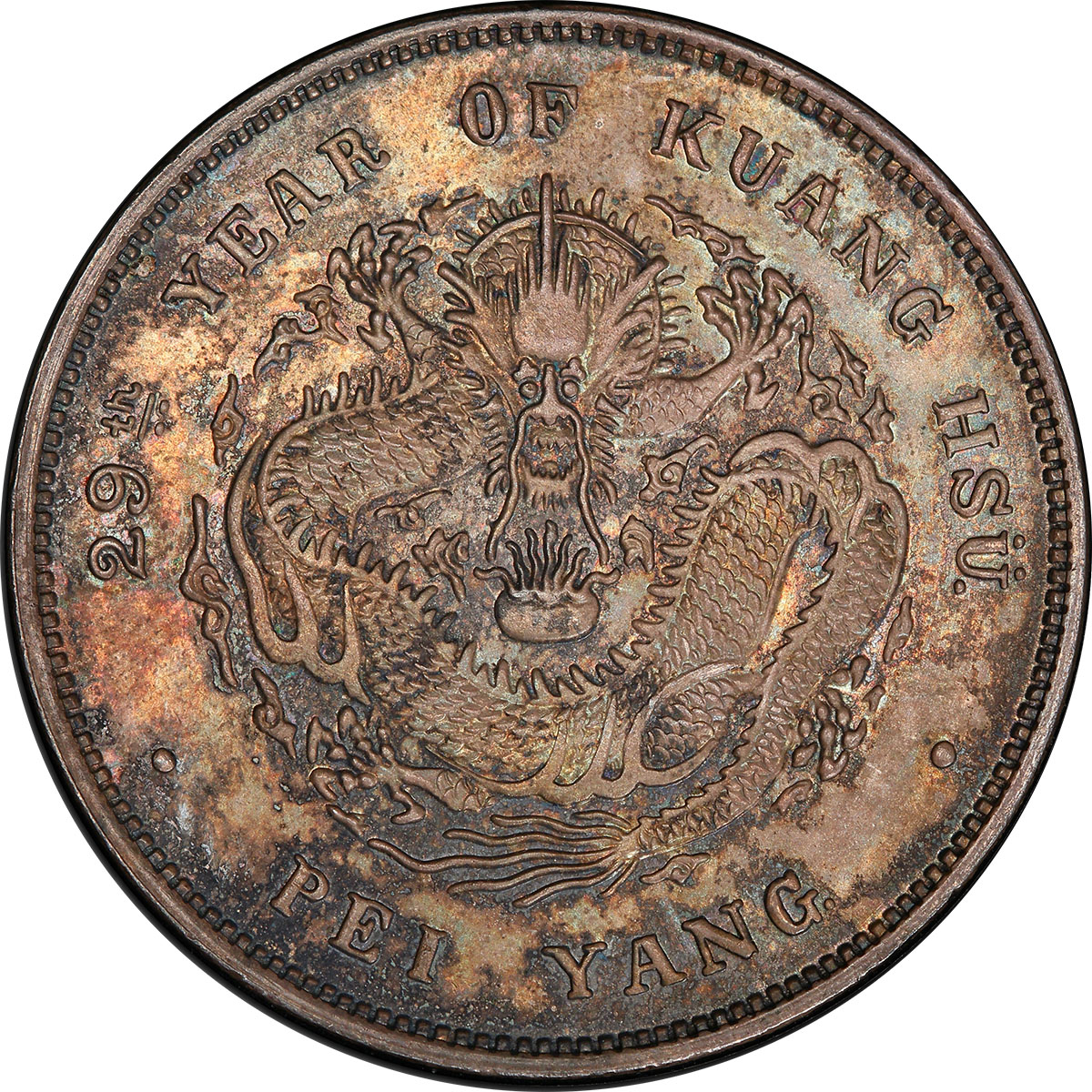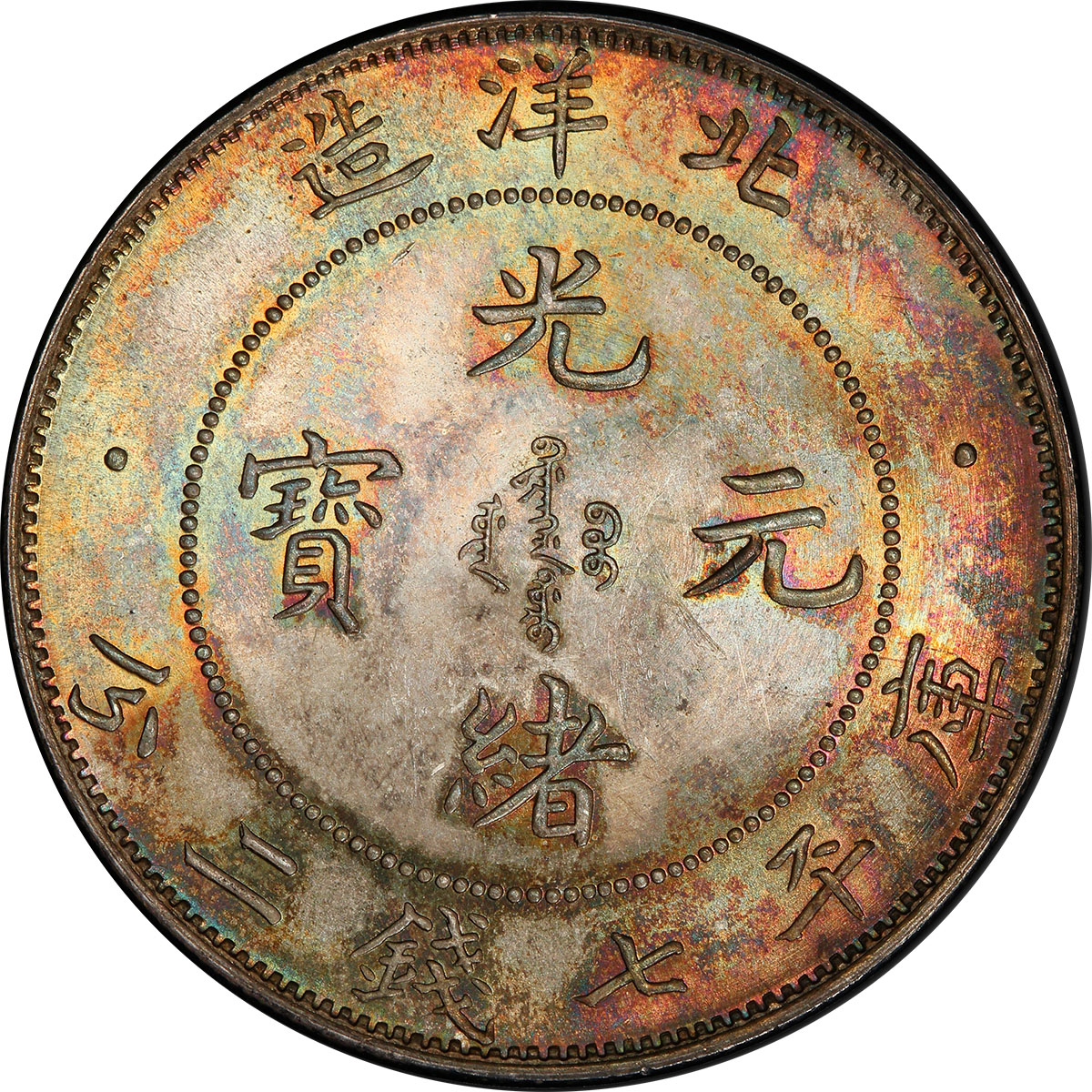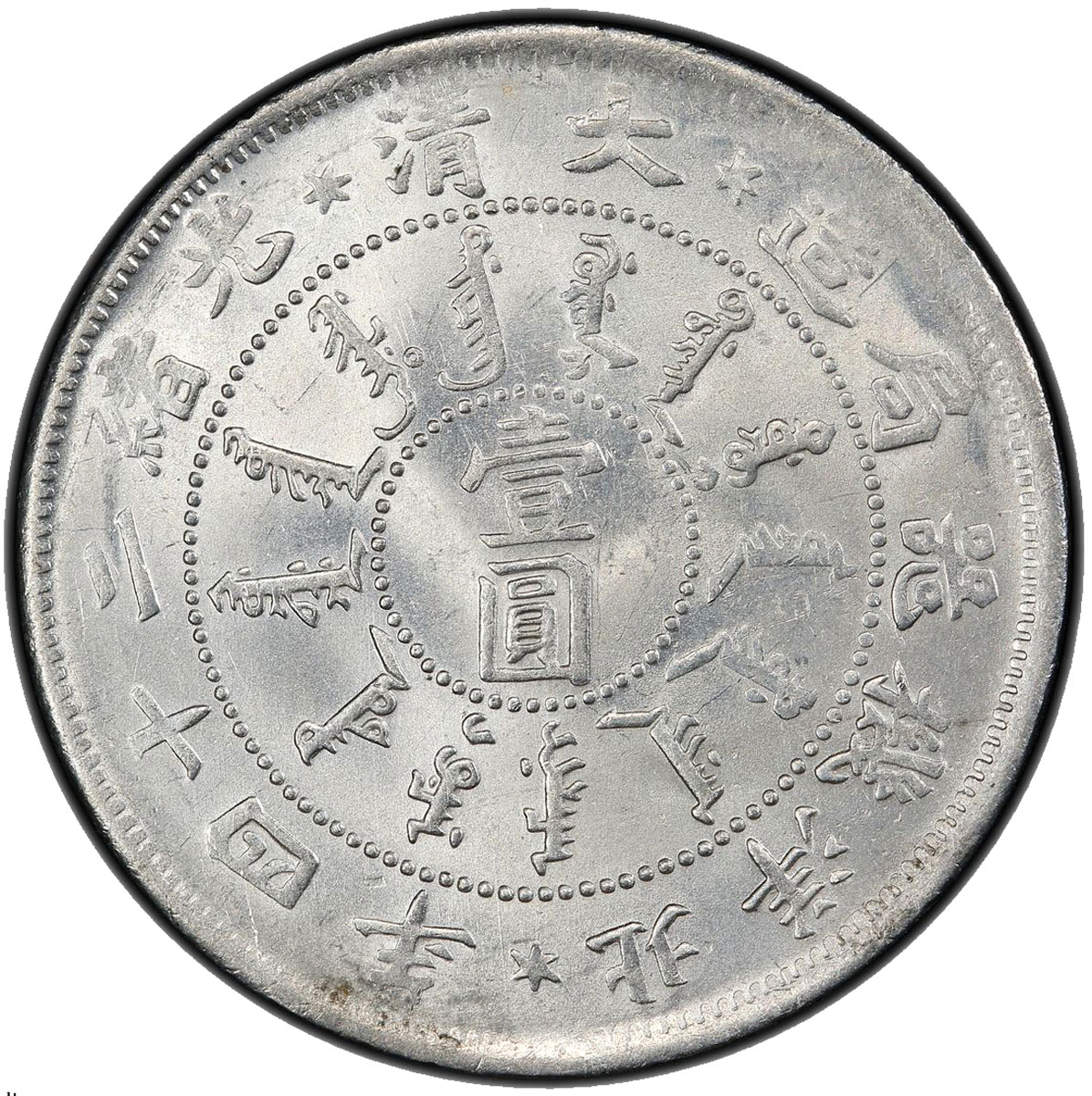 |
|||||
Sale 38
 
|
|||
|
Lot 1169 CHIHLI: Kuang Hsu, 1875-1908, AR dollar, Peiyang Arsenal mint, year 29 (1903), Y-73, L&M-462, with deep original color and iridescent rainbow toning on obverse, NGC graded Specimen 65, RRR, ex Richard Bagge Collection. Part of a two-coin set that was obviously displayed together for a prolonged time as the very old cabinet tone on the obverse of one matches the toning on the reverse of the other. The very bold striking quality is distinctly different especially in the detail in the design elements, lettering and denticles from other Peiyang year 29 dollars we have encountered. The concentric circular die tooling marks either side are indicative of very early strikes from fresh dies as one would expect with Specimen strikes. These are the first of the year 29 Peiyang dollars graded by the grading companies as Specimens. A mint for struck cash was established in 1888 and the mint for the Peiyang silver coinage was added in 1896. This mint was destroyed during the Boxer Rebellion in June 1900 in the Battle of the Taku Forts by Allied forces consisting of Russian, British, Japanese, German, Austro-Hungarian, and Italian troops. A replacement mint was built in 1902 for the provincial coinage and merged with the Tientsin control mint in 1910. Silver dollar production resumed at the mint again in 1903 during the 29th year of Guangxu Emperor. It would seem likely that foreign dignitaries could likely be given specimen strikes as gifts for the re-opening of the mint. Estimate $60,000-80,000 |
|
|
 
|
|||
|
Lot 1170 CHIHLI: Kuang Hsu, 1875-1908, AR dollar, Peiyang Arsenal mint, year 29 (1903), Y-73, L&M-462, with deep original color and iridescent rainbow toning on reverse, NGC graded Specimen 64+, RRR, ex Richard Bagge Collection. Part of a two-coin set that was obviously displayed together for a prolonged time as the very old cabinet tone on the obverse of one matches the toning on the reverse of the other. The very bold striking quality is distinctly different especially in the detail in the design elements, lettering and denticles from other Peiyang year 29 dollars we have encountered. The concentric circular die tooling marks either side are indicative of very early strikes from fresh dies as one would expect with Specimen strikes. These are the first of the year 29 Peiyang dollars graded by the grading companies as Specimens. A mint for struck cash was established in 1888 and the mint for the Peiyang silver coinage was added in 1896. This mint was destroyed during the Boxer Rebellion in June 1900 in the Battle of the Taku Forts by Allied forces consisting of Russian, British, Japanese, German, Austro-Hungarian, and Italian troops. A replacement mint was built in 1902 for the provincial coinage and merged with the Tientsin control mint in 1910. Silver dollar production resumed at the mint again in 1903 during the 29th year of Guangxu Emperor. It would seem likely that foreign dignitaries could likely be given specimen strikes as gifts for the re-opening of the mint. Estimate $50,000-70,000 |
|
|
  
|
|||
|
Lot 1209 KWEICHOW: Republic, AR dollar, year 17 (1928), Y-428, L&M-609, "auto dollar" type, two blades of grass variety, an always immensely popular type and this example is well struck with partial original mint luster in fields, NGC graded AU50. Chou Hsi-ch'eng (Zhou Xicheng) was the provincial warlord and governor of Kweichow (Guizhou) from 1926 to 1929. During his brief tenure, he focused heavily on education and modernizing the province through public works, and was responsible for the province's first machine-struck coin. This fascinating issue commemorates the completion of the Kweichow Provincial Highway, the first modern roadway in the mountainous and impoverished province. It went north and west from Kweiyang (Guiyang), spanning some 220 kilometers. An American engineer, O.J. Todd, who assisted in the project, wrote a book about his work in China that included photographs of Governor Chou and his car, an American model purchased in Canton. Due to Kweichow's inaccessibility, the car had to be taken apart, carried on horseback, and reassembled. It was the first car in the province, and Chou would often drive it around the capital city, drawing huge crowds. So when he decided to mint Kweichow's own silver dollar (on machinery looted by his soldiers from the Chungking Mint according to Bruce Smith), it was an eccentric but appropriate choice to feature his prized personal automobile on the road he built. If you look carefully, you can see his personal name of Hsi-ch'eng (reading from right to left) hidden among the grass. Estimate $30,000-50,000 |
|
|
 
|
|||
|
Lot 1223 TAIWAN: Tao Kuang, 1820-1850, AR dollar, ND (1838-50), Cr-25-3, L&M-319, Kann-1b, so-called "Old Man Dollar", God of Longevity, text in Chinese, dàoguang nián zhù (cast during Daoguang [reign]) and zú wényín bing (pure [fine] silver coin), kùpíng qi èr (treasury standard 7 [mace] 2 [candareens]) // two swastikas on both sides of a bronze vessel, Manchu legend tai wan kiyang ku around, with guan ju stamped in control marks and single Chinese merchant chopmark, plugged and repaired, PCGS graded EF details, ex Kann Collection Sale 1971, Lot 3, with auction tags. Said to be issued in 17th year of Daoguang reign by the local government in order to raise troops to suppress a rebellion led by Zhang Wen. Estimate $15,000-20,000 |
|
|
 
|
|||
|
Lot 1167 CHIHLI: Kuang Hsu, 1875-1908, AR dollar, Peiyang Arsenal mint, Tientsin, year 24 (1898), Y-65.2, L&M-449, dragon eyes in relief, a superb quality example with bright white original mint luster, a superb example! PCGS graded MS63. Estimate $15,000-20,000 |
|
|
  
|
|||
|
Lot 1127 CHINA: Republic, AR dollar, ND (1914), Y-322, L&M-858, Founding of the Republic, facing bust of Yuan Shih Kai in military attire in tall, plumed hat, NGC graded MS61. Estimate $10,000-12,000 |
|
|
 
|
|||
|
Lot 1205 KIRIN: Kuang Hsu, 1875-1908, AR dollar, ND (1898), Y-183, L&M-516, small scales on dragon variety, double struck, much original mint luster, PCGS graded MS62. Estimate $3,500-5,000 |
|
|
 
|
|||
|
Lot 659 QAJAR: Fath 'Ali Shah, 1797-1834, AV presentation toman (4.59g), Isfahan, AH1245, A-2871, KM-763, portrays the king seated on throne, with medallion bearing the ruler's name to the left // mint & date in fancy border, a superb quality example! PCGS graded MS62 (Gold Shield NFC Secure Holder), RRR, ex Dabestani Collection. Portrait presentation coins were issued by Fath Ali Shah from 1245 until 1250, retaining the sahebqirani standard of 4.61g in 1245, then reduced to the keshwarsetan standard of 3.45g either late in 1245 or in 1246, retained until the last issues in 1250. This example was previously sold in January 2015 in our Auction 21 (Lot 573). Estimate $3,000-4,000 |
|
|
 
|
|||
|
Lot 509 GREAT MONGOLS: Chingiz Khan, 1206-1227, AV dinar (3.56g), MM, AH62x, A-1964, obverse legend includes his name, al-khaqan / al-a'zam / chingiz khan, with the kalima in the reverse field; the reverse margin text presumably cites the Abbasid caliph, but only the words amir al-mu'minin are legible; some flatness and flan split, unpublished and presumably unique, VF to EF, RRRR. Estimate $3,250-4,000 |
|
|
 
|
|||
|
Lot 563 ILKHAN: Uljaytu, 1304-1316, AV dinar (11.91g), Wasit, AH710, A-2182, heavy weight, only occasionally encountered for this type; some weakness on the obverse, obscuring most of the Uighur legend in the first segment, full strike on the reverse, EF, RR. Estimate $3,000-3,500 |
|
|
|
Copyright © 2025 by Stephen Album Rare Coins. All rights reserved. P.O. Box 7386 Santa Rosa, California 95407 USA tel: 707.539.2120 fax: 707.540.6001 email: info@stevealbum.com Member: American Numismatic Association American Numismatic Society Oriental Numismatic Society California State Numismatic Association Royal Numismatic Society International Association of Professional Numismatists Mumbai Coin Society Florida United Numismatists Royal Canadian Numismatic Association |